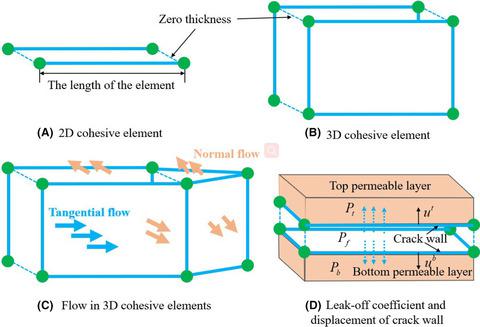当前位置:
X-MOL 学术
›
Energy Sci. Eng.
›
论文详情
Our official English website, www.x-mol.net, welcomes your feedback! (Note: you will need to create a separate account there.)
Three‐dimensional complex fracture propagation simulation: Implications for rapid decline of production capacity
Energy Science & Engineering ( IF 3.8 ) Pub Date : 2020-09-23 , DOI: 10.1002/ese3.804 Yongquan Hu 1 , Qiang Wang 1, 2 , Jinzhou Zhao 1 , Shengnan Chen 2 , Chaoneng Zhao 1 , Chenghao Fu 3
Energy Science & Engineering ( IF 3.8 ) Pub Date : 2020-09-23 , DOI: 10.1002/ese3.804 Yongquan Hu 1 , Qiang Wang 1, 2 , Jinzhou Zhao 1 , Shengnan Chen 2 , Chaoneng Zhao 1 , Chenghao Fu 3
Affiliation

|
In this study, a simulation model of fracture network geometry in fractured and porous elastic reservoirs is established based on the globally embedded three‐dimensional cohesive zone model (3D CZM). The effects of stress interference between natural fractures (NFs), horizontal stress difference (HSD), injection rate, and fluid viscosity on fracture geometry were studied and the phenomenon of rapid failure of unconventional reservoir productivity was explained from a coupling fluid flow/geomechanics perspective. The intersection behavior of hydraulic fracture (HF) and NF is simulated; the simulation results are in good agreement with Blanton's criterion, proving the reliability of the 3D CZM. The research results show that in the process of hydraulic fracturing, in addition to the strong stress interference between HFs, there is also strong stress interference between NFs. Stress interference has an important impact on the traction separation of cohesive elements (CEs) and a continuous dynamic impact on the NF opening. For reservoirs with a small HSD, higher injection rate and fluid viscosity produce smaller stimulated reservoir volume (SRV) length, but larger SRV width. Complex fracture networks tend to develop in the vicinity of horizontal wellbores, which leads to rapid failure of productivity. For this kind of reservoir, minimizing the impact of stress interference with a small injection rate is recommended instead of maximizing the injection rate and fluid viscosity. For reservoirs with a large HSD, lower injection rate and fluid viscosity produce larger SRV length and smaller SRV width. The fracture geometries tend to develop simple straight fractures, which leads to low initial productivity. Thus, adopting a relatively large injection rate and fluid viscosity is recommended to make full use of stress interference effects to increase the development of complex fractures near horizontal wellbores. The results of this study can serve as a guide in evaluating fracture complexity, SRV, proppant migration, drainage reservoir volume (DRV), and well completion design; they can also promote the in‐depth understanding of the coupling effect between fluid flow and geomechanics.
中文翻译:

三维复杂裂缝扩展模拟:对产能快速下降的启示
在这项研究中,基于全球嵌入的三维粘性带模型(3D CZM)建立了裂缝性和多孔弹性储层的裂缝网络几何模拟模型。研究了天然裂缝(NFs),水平应力差(HSD),注入速率和流体粘度之间的应力干扰对裂缝几何形状的影响,并从流体流动/地质力学的角度解释了非常规油藏产能快速衰竭的现象。 。模拟了水力压裂(NF)与NF的相交行为;仿真结果与Blanton准则吻合良好,证明了3D CZM的可靠性。研究结果表明,在水力压裂过程中,HF之间除了强烈的应力干扰外,NF之间也存在强烈的应力干扰。应力干扰对内聚元件(CE)的牵引力分离有重要影响,并且对NF开口持续产生动态影响。对于HSD较小的储层,较高的注入速率和流体粘度会产生较小的受激储层体积(SRV)长度,但会增大SRV宽度。复杂的裂缝网络倾向于在水平井眼附近发展,这导致生产率迅速下降。对于这种油藏,建议以较小的注入速率使应力干扰的影响最小化,而不是使注入速率和流体粘度最大化。对于HSD较大的储层,较低的注入速率和流体粘度会产生较大的SRV长度和较小的SRV宽度。裂缝的几何形状倾向于发展为简单的直形裂缝,这导致较低的初始生产率。因此,建议采用较大的注入速率和流体粘度,以充分利用应力干扰效应,以增加水平井眼附近复杂裂缝的发展。这项研究的结果可作为评估裂缝复杂性,SRV,支撑剂运移,排水储层体积(DRV)和完井设计的指导。他们还可以促进对流体流动与地质力学之间耦合效应的深入了解。支撑剂运移,排水库容积(DRV)和完井设计;他们还可以促进对流体流动与地质力学之间耦合效应的深入了解。支撑剂运移,排水库容积(DRV)和完井设计;它们还可以促进对流体流动与地质力学之间耦合效应的深入了解。
更新日期:2020-09-23
中文翻译:

三维复杂裂缝扩展模拟:对产能快速下降的启示
在这项研究中,基于全球嵌入的三维粘性带模型(3D CZM)建立了裂缝性和多孔弹性储层的裂缝网络几何模拟模型。研究了天然裂缝(NFs),水平应力差(HSD),注入速率和流体粘度之间的应力干扰对裂缝几何形状的影响,并从流体流动/地质力学的角度解释了非常规油藏产能快速衰竭的现象。 。模拟了水力压裂(NF)与NF的相交行为;仿真结果与Blanton准则吻合良好,证明了3D CZM的可靠性。研究结果表明,在水力压裂过程中,HF之间除了强烈的应力干扰外,NF之间也存在强烈的应力干扰。应力干扰对内聚元件(CE)的牵引力分离有重要影响,并且对NF开口持续产生动态影响。对于HSD较小的储层,较高的注入速率和流体粘度会产生较小的受激储层体积(SRV)长度,但会增大SRV宽度。复杂的裂缝网络倾向于在水平井眼附近发展,这导致生产率迅速下降。对于这种油藏,建议以较小的注入速率使应力干扰的影响最小化,而不是使注入速率和流体粘度最大化。对于HSD较大的储层,较低的注入速率和流体粘度会产生较大的SRV长度和较小的SRV宽度。裂缝的几何形状倾向于发展为简单的直形裂缝,这导致较低的初始生产率。因此,建议采用较大的注入速率和流体粘度,以充分利用应力干扰效应,以增加水平井眼附近复杂裂缝的发展。这项研究的结果可作为评估裂缝复杂性,SRV,支撑剂运移,排水储层体积(DRV)和完井设计的指导。他们还可以促进对流体流动与地质力学之间耦合效应的深入了解。支撑剂运移,排水库容积(DRV)和完井设计;他们还可以促进对流体流动与地质力学之间耦合效应的深入了解。支撑剂运移,排水库容积(DRV)和完井设计;它们还可以促进对流体流动与地质力学之间耦合效应的深入了解。



























 京公网安备 11010802027423号
京公网安备 11010802027423号